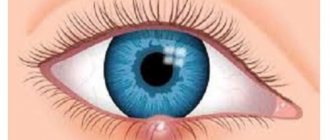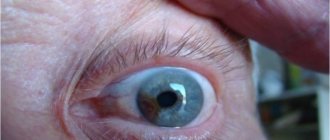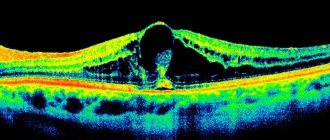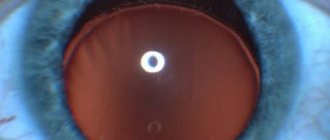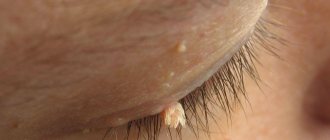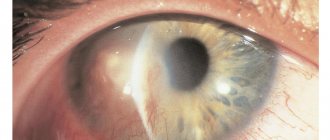Causes Symptoms Diagnostics Treatment Video of surgery Our advantages Prices
A pinguecula is a benign round-shaped formation located on the conjunctiva of the eye. The pinguecula usually has a characteristic appearance: small in size (no larger than a match head), yellowish in color, slightly protruding above the surface of the conjunctiva, most often found on the nasal side, but can also be located outside the cornea. The disease can be unilateral or bilateral.
Causes of pinguecula
Doctors have fully elucidated the cause of pinguecula formation. It is believed that it is provoked by metabolic disorders in the area of proteins and fats. Most often, the condition develops in men and women after 60 years of age, when an inevitable change occurs in the body.
Also, formation can appear at an earlier age if, in addition to metabolic disorders, the patient develops the negative impact of various environmental factors:
- prolonged exposure to ultraviolet and infrared radiation on the surface structure of the eyes;
- disturbance of nutrition of the cornea through the vessels during dystrophic changes;
- prolonged wearing of contact lenses, which causes mechanical damage and irritation of the cornea;
- periodic mechanical damage, scar formation on the surface structure of the eyes;
- exposure to smoke, various toxic substances, and chemicals that must be formed over a long period of time;
- decrease in the number of collagen fibers in eye tissues.
If a patient has a yellow lump on the conjunctiva, the doctor will first suspect a pinguecula. But he also needs to identify the true cause of the condition in order to completely eliminate the risk of relapse.
Types of acne on the eyeball and their characteristics
Doctors divide acne on the eyeball into 4 main types, each of which has its own characteristics and causes, in particular:
Pinguecula
This formation is an inflamed pimple that has a yellowish-white color and is located on the surface of the eyeball. Such acne very often appears in elderly and sometimes middle-aged people, in most cases in men.
Most often, such formations arise due to:
- Exposure to ultraviolet rays;
- Natural aging;
- Frequent eye irritation from dust, debris and wind;
- Excessive dry eyes.
Typically, pinguecules are yellow or white bumps against the background of a white eyeball, located on the side of the nose. Only in some cases such formations appear on the eyeball from the side of the ears.
Symptoms of such formation can be called:
- Dryness of the surface of the eyeball;
- Burning;
- Itching;
- Redness, swelling and other signs of the inflammatory process;
- Feeling of a foreign body in the eye.
Pinguecules are inflammatory neoplasms that require constant monitoring by a specialist. Therefore, if you find acne on the eyeball of this type, you should consult a doctor and get the necessary recommendations. If the size of the tumors increases, causes discomfort, and interferes with the wearing of contact lenses, then in such a situation urgent treatment is required with the use of special eye drops prescribed by the doctor on an individual basis.
Pterygium
In this case, the pimple in the eye on the white takes on a raised wedge-shaped shape and a color ranging from white to pink, we can conclude that there is a pterygium. This neoplasm is also inflammatory in nature. People often call this disorder “farmer’s eye” or “surfer’s eye.”
The exact reasons for the appearance of this type of neoplasm have not yet been identified, but as a result of research it has been established that prolonged and frequent exposure to the wind, especially in the presence of dust, as well as in bright sun provokes the development of an inflammatory process, which leads to the appearance of pterygium. Residents of regions with very dry and hot climates are most susceptible to the appearance of such acne.
As a rule, such formations do not pose a threat to eye health, but they can cause serious discomfort and grow quite quickly, reducing visual acuity and preventing the wearing of contact lenses. For this reason, it is better not to delay a visit to the doctor and adequate therapy, since in advanced conditions, treatment of such neoplasms is carried out surgically.
In addition to rapid growth, pterygium also has some other symptoms, including:
- The appearance of excessive dryness of the ocular surface;
- In the appearance of a wedge-shaped growth on the inside of the eye, closer to the nose;
- The appearance of blurred vision or astigmatism, especially when the tumor enters the central cornea area.
If pterygium does not cause anxiety or discomfort to a person, the doctor may recommend the use of artificial tears to increase the moisture on the surface of the eyeball and prevent possible deterioration. However, such neoplasms require constant monitoring and testing by a specialist, since their growth can impair vision. Therefore, it is recommended to undergo surgery to remove acne of this type before the level of vision begins to decline.
Conjunctivitis on the eyeball
Conjunctivitis on the surface of the eye is an overgrowth of a transparent membrane (conjunctiva) that covers the entire surface of the eye. Such a neoplasm can quite often be caused by a tumor. This reason is usually indicated by a rapid increase in the size of the pathogenic element.
Such neoplasms can be different. They can be small in size, appear fixed, or look quite impressive, being quite fleshy and thick. Such elements can be located not only on the white part of the eyeball, but also above the cornea.
As a rule, formations that have a fairly wide diameter in most cases turn out to be tumors, and depending on external signs and color, such tumors can be cancerous, precancerous or malignant. In most cases, this disorder occurs in older people who are often exposed to the sun for long periods of time. Also, neoplasms can occur in people of any age if they have a weak immune system.
Treatment for pimples on the eyeball of this type is carried out only by removing them, which can be done in different ways, for example, using surgery of various sizes or cryotherapy, which depends on the type of tumor present.
Limbal dermatitis
This neoplasm is considered a benign tumor that appears on the eyeball in children. The element is a white pimple located near the pupil, and it can cover not only the white part of the eye, but also the colored part.
In most cases, such neoplasms do not cause harm, but they can affect the child’s vision. Treatment for such tumors involves surgery, which is recommended before vision begins to deteriorate. If the tumor is growing rapidly, surgery should be performed as early as possible, since if it develops strongly, the child may develop astigmatism.
Risk group
The risk group includes the following categories of patients:
- men and women over 60 years of age;
- people with metabolic disorders in the area of proteins and fats, especially those accompanied by a decrease in the amount of collagen fibers in the body;
- people whose work involves prolonged exposure to the sun, for example, janitors, road service workers, police officers from the State Traffic Inspectorate.
These categories of patients should periodically visit an ophthalmologist and undergo diagnostic tests, especially if they experience metabolic changes.
Reasons for the formation of a lump
Experts identify various reasons that can provoke the appearance of growths of different types and colors on the white of the eye. The main reason for the formation of growths is the degeneration of a certain zone of epithelial tissue covering the eyeball. In addition, the reason may lie in the formation of a compaction from cells that have changed their own structure. It is imperative to pay attention to white, transparent or yellow growths and visit a specialist.
Yellow growths
Medical practice shows that the reason for the formation of yellow growths on the eye is hidden in the accumulation of excess animal fats in the human body. Every day a person absorbs them along with food, and the organs of the digestive system simply cannot cope with the increase in such fatty foods.
Transparent growths
Clear growths may appear on the conjunctiva of the eye, and this often occurs for various reasons. Among them, the most common is considered to be excessive consumption of protein foods during the day. In some cases, patients encounter this problem if they have stones in the bladder or kidneys. All symptoms that arise are usually interrelated and indicate an excess of proteins in the diet.
Symptoms of pinguecula
If the formation has just appeared, it will have a small, compacted, round shape. It is located in the conjunctival area, closer to the nose. Usually the pigmentation should be yellow, but if the conjunctiva is overly irritated, there will be severe redness along the edges.
If symptomatic therapy does not occur, the formation gradually increases in size, therefore leading to the following symptoms:
- hyperemia of the conjunctiva of the eye;
- sensation of a foreign body under the eyelids, due to which the patient begins to periodically rub his eyes, which further aggravates the condition;
- at first, increased production of tears occurs;
- then excessive dryness of the eyes appears, leading to microtraumas on the surface of the cornea;
- excessive sensitivity to bright light;
- if the formation reaches a large size, irritation of the conjunctiva and clouding of the cornea appear, this condition is called pingueculitis.
The formation can form on the conjunctiva of the eye for a long time. In this case, there is practically no discomfort felt. The pinguecula cannot degenerate into malignant formations, but still gradually increases in size.
What kind of disease is pinguecula of the eye?
A pinguecula is a benign formation on the cornea of the eye , most often occurring in older people.
It is also called wen on the eye , because the composition of the neoplasm consists of adipose tissue. Find out about the causes of vision loss here.
It does not pose a danger to life or vision , but rather indicates the accumulation of adipose tissue on the cornea due to the gradual aging of the body.
Pinguecula most often appears on the inside of the cornea (closer to the bridge of the nose) and in both eyes at once.
The symptoms are the following:
- Pain when blinking and other movements.
- Dry eye syndrome.
- Burning and discomfort.
- Redness of the capillary network of the eye.
If you notice such symptoms, it is best to consult a doctor immediately.
Despite the benign nature of the neoplasm, which is the pinguecula, its course can be complicated by associated factors: infection and inflammation of the eyeball.
In this case, vision function may be impaired, and the usual way of life suffers from discomfort and soreness of the cornea. Find out about the symptoms of uveitis, as well as methods of its treatment, at this link.
On video: what is a pinguecula?
Diagnostics
When contacting an ophthalmologist with symptoms of pinguecula, several diagnostic tools are performed to eliminate the risk of malignancy:
- Collecting information from the patient. He tells the doctor when the yellow lump formed and what symptoms he feels. Does he feel worse?
- General inspection. If the condition has just appeared, the doctor will only be able to detect a yellow lump on the inner corner of the eyes. If it has greatly increased in size, you can see clouding of the cornea and severe redness of the conjunctiva.
- Biomicroscopy. This is a study that can be used to identify the cellular composition of the conjunctiva and cornea of the eye. To do this, there is no need to remove a piece of tissue, since the device is directly brought to the patient’s eyes. Under a microscope, yellow formations lacking blood supply are visible. The doctor can completely rule out the presence of malignant cells.
- Angiography. This is a study that allows you to identify the condition of the choroid of the eyes.
- Optical coherence tomograph. The study allows the doctor to detect the structure of the eyeball layer by layer in order to identify the presence or absence of other pathological changes.
- Fundus examination. This is one of the main ophthalmological studies that allows us to identify the condition of all internal elements of the eye. The ophthalmologist determines the degree of pinguecula growth and the presence or absence of complications under the cornea.
- Bacteriological culture. The test is performed if a complication in the form of a bacterial infection is suspected. The laboratory technician determines not only the bacteria, but also the antibiotic to which it is sensitive.
After completing all diagnostic methods, the doctor makes a reliable diagnosis and begins to treat the patient.
Treatment with folk remedies
Non-traditional treatment of pinguecula is aimed at eliminating unpleasant symptoms and preventing further growth of the tumor. They can be used in the absence of pronounced symptoms of the disease and purulent-inflammatory processes - in these cases, traditional treatment cannot be avoided.
Traditional treatment methods:
- Wash and chop the beet tops thoroughly, wrap in gauze and apply to the affected eye.
- Brew 1 teaspoon of chamomile, plantain, sage or eyebright in a glass of boiling water. Leave for half an hour, strain and use for compresses or nightly eye washes.
- Pour two tablespoons of dry kelp into a glass of water, leave for several hours, and strain. Freeze the resulting solution in ice cube trays. Every morning, wipe the sore eye with light massaging movements.
The most effective products are those made from blueberries:
- Pour a handful of dry berries into two glasses of water, leave for two hours, use for lotions twice a day.
- Mix fresh blueberry juice with boiled water in equal proportions, soak a cotton pad in it and apply to the sore eye.
If you pick blueberries in the summer and eat a handful every day, the effect of treatment will be even stronger, since the berries contain vitamins that are good for vision. For the winter, the berries need to be dried and periodically brewed to provide the eyes with the necessary nutrients.
Treatment
If the formation reaches only a small size and does not cause discomfort in the patient, no treatment methods are performed. Treatment begins only if the pinguecula constantly increases, which leads to discomfort and other pathological symptoms.
Therapy can be carried out conservatively. If the pinguecula has reached its maximum size, surgical removal is indicated.
Conservative treatment methods
The following medications are used to reduce discomfort from the formation:
- moisturizing eye drops that eliminate dryness and irritation of the cornea (Slezin, Defislez);
- non-steroidal anti-inflammatory drugs based on diclofenac;
- if excessive redness and inflammation occurs, the doctor will prescribe steroidal anti-inflammatory drugs based on dexamethasone or hydrocortisone, as well as local antibacterial therapy (Tsiprolet, Vigamox);
- vasoconstrictor drops, which are used for no more than 4 days for excessive redness (Visin).
In addition to the use of medications, the patient is advised not to wear contact lenses during treatment. This will prevent excessive irritation in the cornea and conjunctiva, which prevents the pinguecula from enlarging.
Surgical removal
The technique is indicated for eliminating a cosmetic defect, with an excessively enlarged formation, or the development of pingueculitis. It is also recommended to remove it if the effect of conservative therapy is not observed.
To remove the formation, an excimer laser is used, with which the required area is burned. This is done under local anesthesia. The operation lasts 10-15 minutes, after which the patient is discharged home if he does not develop any complications.
After the operation, a rehabilitation period begins, during which it is recommended to wear sunglasses outside and use antibacterial and anti-inflammatory drops.
A sterile bandage is put on the eye for several days, which prevents the entry of toxic substances, dust, dirt and ultraviolet radiation.
After the rehabilitation period, you should see a doctor again.
Treatment prognosis and possible complications
Pinguecula is a benign formation, so the prognosis of the disease for vital functions and preservation of vision is favorable. Occasionally, a pinguecula can be complicated by a pterygium (pterygoid hymen), which can seriously impair visual function.
Surgical removal of the growth, as a rule, does not cause complications, but the pinguecula has a tendency to recur. Unfortunately, after its removal with a laser, in about 10% of cases the disease may return (relapse), that is, the pinguecula forms again.
In case of relapse, a benign formation grows even more rapidly and quickly acquires large sizes.
To prevent recurrence of the disease, you need to take care of your eyes and follow preventive and precautionary measures.
Complications of pinguecula
If a yellow seal appears in the eyes, it can lead to the following complications for the visual organs:
- development of a bacterial infection with suppuration;
- conjunctivitis;
- pingueculitis - an inflammatory reaction from the pinguecula, accompanied by redness, irritation, and swelling of the tissues;
- Pterygium is a triangular-shaped growth on the cornea that starts from the inner corner of the eye, reaching the pupil area; most often, pathological symptoms do not form, but can interfere with normal vision.
To avoid complications, it is recommended to periodically visit an ophthalmologist to monitor the pinguecula.
Symptoms
In many cases, the presence of a pinguecula is asymptomatic and does not threaten visual function. There is also no tendency for the pinguecula to grow into the cornea. However, as the volume increases, patients gradually begin to feel a foreign body in the eye; it is sometimes described as "scratching the eyelid from the inside." In some cases, there is redness around the thickening, less often - swelling.
Under unfavorable conditions, local inflammation may develop, for which a special name “pingueculitis” has even been introduced.
Complaints of dry eyes are common.
However, the most common reason for seeking help, including ophthalmic surgery, is a cosmetic defect, which can be quite noticeable, and the associated psychological discomfort.
Prevention
To prevent the formation of a yellow spot on the conjunctiva, it is recommended to adhere to the following rules:
- wear contact lenses, observing all hygiene rules;
- wear sunglasses that protect your eyes from ultraviolet radiation, wind, dirt, dust;
- promptly correct metabolic disorders in the area of fat and protein metabolism.
Compliance with the rules of prevention will not completely eliminate the risk of pinguecula formation, but will significantly reduce it.
Formation of the disease
A yellowish spot near the iris of the eye
The pinguecula of the eye appears due to transformations in the collagen structure of the conjunctiva of the eyeballs. This neoplasm is located directly on the outer mucous membrane of the eye and is localized mainly in the inner corner. The tumor forms gradually, but does not interfere with the functioning of the internal nerve, therefore, the quality of a person’s vision remains unchanged. In most cases, eye growth is observed in elderly patients as the most common disease associated with pathological changes in the eye.
This tumor does not affect vision impairment
There is an opinion that the pinguecula may in the future transform into a malignant neoplasm. However, ophthalmologists refute this myth, explaining that the tumor is only a defect of the eye tissue and does not become malignant even in the absence of proper therapy.
Symptoms and diagnosis of the disease
Pinguecula develops slowly, without pronounced symptoms, and does not degenerate into a malignant form. In the corner of the eye near the nose, a transparent yellow nodule is clearly visible, which over time can grow to the pupil. The patient feels the presence of a foreign body while blinking, as if hit by a speck. 90% of people do not go to the doctor after noticing similar symptoms. A health concern is pingueculitis, an inflammation of the growth. It is accompanied by unpleasant painful symptoms:
- swelling of the mucous membrane of the eye;
- redness of the eyeball, eyelid;
- pain and burning when blinking;
- feeling of dryness.
The disease is diagnosed by an ophthalmologist during a routine examination. Using a special device - a slit lamp - the ophthalmologist assesses the condition of the conjunctiva of the eyelid, the body and vaults of the eye, blood vessels, the nature of the discharge, the presence/absence of inflammatory and degenerative processes. Examination of the organs of vision under a microscope is painless. Additional laboratory tests are not performed to diagnose eye growths.
Treatment of a growth on the eye must be carried out with an ophthalmologist.
Surgery
Usually they resort to surgical intervention when the growth begins to cause discomfort to a person, as well as when they want to get rid of a cosmetic defect.
The tumor is removed using one of two methods:
- Knife removal;
- Laser therapy.
In the first case, the surgeon fixes the eye and instills it with the anesthetic Inocaine. Using sterile instruments, the neoplasm is removed from the mucous membrane.
Laser therapy involves the use of an excimer laser. This technique has virtually no disadvantages and is characterized by the absence of adverse reactions. Removing growth with a laser has a number of advantages:
- The removal procedure is painless;
- No bleeding occurs;
- The operation does not take long;
- The patient is not hospitalized;
- The person goes home on the same day, after which it is necessary to control the result for some time.
But some doctors say that there are still risks when performing the operation. These include:
- The appearance of complications;
- Infection of the organs of vision, causing decreased vision.
